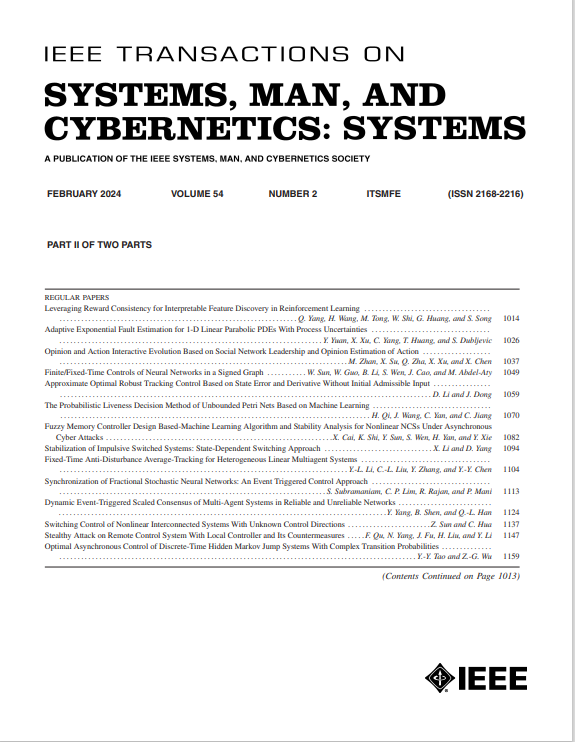定向网络稀疏恢复的分布式惯性近端神经动力学方法
IF 8.6
1区 计算机科学
Q1 AUTOMATION & CONTROL SYSTEMS
IEEE Transactions on Systems Man Cybernetics-Systems
Pub Date : 2024-07-31
DOI:10.1109/TSMC.2024.3408473
引用次数: 0
摘要
本文研究了一种用于稀疏恢复的全分布式惯性神经动力学方法。该方法以近算子和惯性项为基础。它旨在通过有向通信网络解决具有共识和线性观测约束的 $L_{1}$ -norm 最小化问题。所提出的神经动力学方法的优点是只要求通信网络是有向和权重平衡的,不涉及中央处理节点和全局参数,这意味着没有任何一个节点可以随时访问整个网络并对其进行观测,因此它是完全分布式的。为了有效处理非光滑目标函数 $L_{1}$ -norm,这里使用了近似算子法。为有效处理线性观测和共识约束,对惯性动态系统采用了初等二元法。借助最大单调算子理论和 Baillon-Haddad 定理,我们发现只要分布参数满足技术条件,我们方法的轨迹就能在最优解处收敛到共识解。此外,我们还利用 Opial's lemma 证明了我们提出的神经动力学方法的轨迹对希尔伯特空间中最优算子零点的弱收敛性。最后,稀疏信号和图像复原的对比实验证实了我们提出的神经动力学方法的效率和有效性。本文章由计算机程序翻译,如有差异,请以英文原文为准。
Distributed Inertial Proximal Neurodynamic Approach for Sparse Recovery on Directed Networks
This article investigates a fully distributed inertial neurodynamic approach for sparse recovery. The approach is based on proximal operators and inertia items. It aims to solve the
$L_{1}$
-norm minimization problem with consensus and linear observation constraints over directed communication networks. The proposed neurodynamic approach has the advantages of only requiring the communication network to be directed and weight-balanced, does not involve a central processing node and global parameters, which means that no single node can access the entire network and observe it at any time, so it is fully distributed. To effectively deal with the nonsmooth objective function,
$L_{1}$
-norm, the proximal operator method is used here. For efficiently handling linear observation and consensus constraints, a primal-dual method is applied to the inertial dynamic system. With the aid of maximal monotone operator theory and Baillon-Haddad lemmas, it reveals that the trajectories of our approach can converge to consensus solution at the optimal solution, provided that the distributed parameters satisfy technical conditions. In addition, we aim to demonstrate the weak convergence of the trajectories in our proposed neurodynamic approach toward the zeros of the optimal operator in Hilbert space, using Opial’s lemma. Finally, comparative experiments on sparse signal and image recovery confirm the efficiency and effectiveness of our proposed neurodynamic approach.
求助全文
通过发布文献求助,成功后即可免费获取论文全文。
去求助
来源期刊

IEEE Transactions on Systems Man Cybernetics-Systems
AUTOMATION & CONTROL SYSTEMS-COMPUTER SCIENCE, CYBERNETICS
CiteScore
18.50
自引率
11.50%
发文量
812
审稿时长
6 months
期刊介绍:
The IEEE Transactions on Systems, Man, and Cybernetics: Systems encompasses the fields of systems engineering, covering issue formulation, analysis, and modeling throughout the systems engineering lifecycle phases. It addresses decision-making, issue interpretation, systems management, processes, and various methods such as optimization, modeling, and simulation in the development and deployment of large systems.
 求助内容:
求助内容: 应助结果提醒方式:
应助结果提醒方式:


